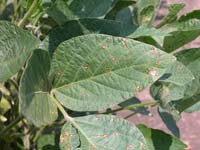
-
Soybean Diseases
- Asian Rust
- Anthracnose
- Bacterial Blight
- Bacterial Pustule
- Bean Pod Mottle Virus
- Brown Stem Rot
- Cercospora Leaf Blight
- Charcoal Rot
- Downy Mildew
- Frogeye Leaf Spot
- Green Stem Syndrome
- Iron Deficiency Chlorosis
- Phytophthora Root & Stem Rot
- Powdery Mildew
- Rhizoctonia
- Seedling Diseases
- Septoria (Brown Spot)
- SCN (Soybean Cyst Nematode)
- Soybean Mosaic Virus
- Stem Canker
- Sudden Death Syndrome
- Viruses
- White Mold
- Soybean Pests
- Diagnostic Help
- Field Trials
- Soybean Library
| Disease: Frogeye Leaf Spot |
Your Soybean Checkoff.
Delivering Results.
Illinois
Indiana
Iowa
Kansas
Michigan
Minnesota
Missouri
Nebraska
North Dakota
Ohio
South Dakota
Wisconsin
Frogeye Leaf Spot
 |
| Symptoms of frogeye leaf spot are first noticeable after plants begin to bloom. Click on image to view a larger version. Photo credit: A. Wrather, University of Missouri |
Frogeye leaf spot is a major disease of soybean, especially in the southern U.S. The distribution of this disease has expanded into the northern soybean-growing areas and has increasingly suppressed soybean yields in the northern U.S. the past few years. Since 2003, frogeye leaf spot ranked tenth on the list of 21 major diseases that suppressed U.S. soybean yield.
Frogeye leaf spot is caused by the fungus Cercospora sojina. This fungus most often infects soybean leaves, but it may also infect pods, seeds, and stems. It survives between growing seasons on undecomposed soybean residue in the field including leaves, stems, and pods, and it can survive on seeds in storage. When planted, infected seed may give rise to infected seedlings.
Leaf symptoms are first noticeable after plants begin to bloom. Infection and disease spread are greater during warm, humid weather with cloudy days and frequent rain.
Frogeye leaf spot can be managed by planting resistant soybean cultivars. Several high-yielding resistant varieties resistant to frogeye leaf spot are available for planting in the southern U.S., but few are available for planting in the northern U.S. Frogeye leaf spot may also be managed by rotation and by application of foliar fungicides, especially the strobilurins, from the R3 to R5 growth stage.
